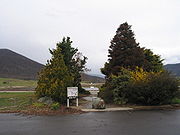
Orroral Valley Tracking Station
Encyclopedia

NASA
The National Aeronautics and Space Administration is the agency of the United States government that is responsible for the nation's civilian space program and for aeronautics and aerospace research...
's Spacecraft Tracking and Data Acquisition Network
Spacecraft Tracking and Data Acquisition Network
The Spacecraft Tracking and Data Network was established by NASA to satisfy the requirement for long-duration, highly-available space-to-ground communications...
(STADAN). It is located approximately 50 kilometres south of Canberra
Canberra
Canberra is the capital city of Australia. With a population of over 345,000, it is Australia's largest inland city and the eighth-largest city overall. The city is located at the northern end of the Australian Capital Territory , south-west of Sydney, and north-east of Melbourne...
, Australian Capital Territory
Australian Capital Territory
The Australian Capital Territory, often abbreviated ACT, is the capital territory of the Commonwealth of Australia and is the smallest self-governing internal territory...
(ACT). It was one of three tracking stations in the ACT, and seven in Australia
Australia
Australia , officially the Commonwealth of Australia, is a country in the Southern Hemisphere comprising the mainland of the Australian continent, the island of Tasmania, and numerous smaller islands in the Indian and Pacific Oceans. It is the world's sixth-largest country by total area...
.
Construction of the site commenced shortly after site selection
Site selection
Site Selection indicates the practice of new facility location, both for business and government. Site selection involves measuring the needs of a new project against the merits of potential locations...
in 1963 and was completed in May 1965. It was home to a 26 metre antenna and several smaller VHF
Very high frequency
Very high frequency is the radio frequency range from 30 MHz to 300 MHz. Frequencies immediately below VHF are denoted High frequency , and the next higher frequencies are known as Ultra high frequency...
and microwave
Microwave
Microwaves, a subset of radio waves, have wavelengths ranging from as long as one meter to as short as one millimeter, or equivalently, with frequencies between 300 MHz and 300 GHz. This broad definition includes both UHF and EHF , and various sources use different boundaries...
frequency antennas.
The main requirement of the station, as distinct from the long-range communication tasks of Tidbinbilla
Canberra Deep Space Communication Complex
The Canberra Deep Space Communication Complex is a ground station that is located in Australia at Tidbinbilla in the Paddys River valley, about half an hour's drive out of Canberra in the Australian Capital Territory. The complex is part of the Deep Space Network run by NASA's Jet Propulsion...
and Honeysuckle Creek
Honeysuckle Creek Tracking Station
Honeysuckle Creek was a NASA tracking station near Canberra, Australia, which played an important role in supporting Project Apollo. The station was opened in 1967 and closed in 1981....
, was to be able to quickly switch from supporting one satellite to another. The signal received from satellite
Satellite
In the context of spaceflight, a satellite is an object which has been placed into orbit by human endeavour. Such objects are sometimes called artificial satellites to distinguish them from natural satellites such as the Moon....
s in Earth orbit are relatively strong but view periods are short; a few minutes being typical. Many of the supported satellites used different systems for transmitting data, or for receiving commands so the station had to cope with a variety of equipment for support of the individual satellites. Data from the satellites were recorded on magnetic tape and air-freighted to the United States for study.
The station supported the joint Apollo-Soyuz
Apollo-Soyuz Test Project
-Backup crew:-Crew notes:Jack Swigert had originally been assigned as the command module pilot for the ASTP prime crew, but prior to the official announcement he was removed as punishment for his involvement in the Apollo 15 postage stamp scandal.-Soyuz crew:...
project in 1975, which saw American astronauts and Soviet cosmonauts link in Earth orbit and conduct joint experiments in space. In April 1981, Orroral tracking station supported the Space Shuttle Columbia
Space Shuttle Columbia
Space Shuttle Columbia was the first spaceworthy Space Shuttle in NASA's orbital fleet. First launched on the STS-1 mission, the first of the Space Shuttle program, it completed 27 missions before being destroyed during re-entry on February 1, 2003 near the end of its 28th, STS-107. All seven crew...
. It provided telecommunication support to Space Shuttle
Space Shuttle
The Space Shuttle was a manned orbital rocket and spacecraft system operated by NASA on 135 missions from 1981 to 2011. The system combined rocket launch, orbital spacecraft, and re-entry spaceplane with modular add-ons...
missions until its closure in 1985.
The 26m telescope was moved in 1985 to Tasmania, Australia, and now forms the core of the Mt. Pleasant Radio Observatory run by the School of Mathematics and Physics, University of Tasmania.

